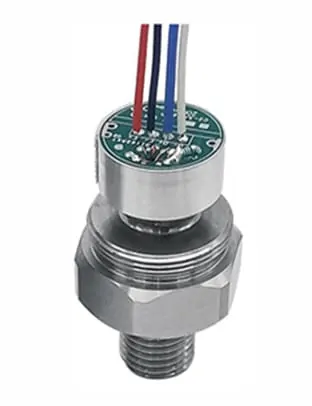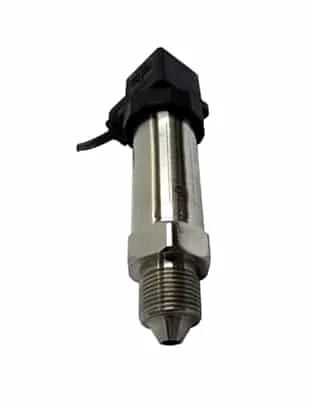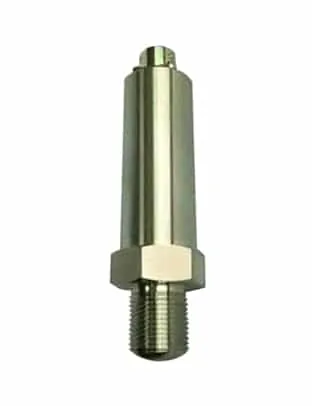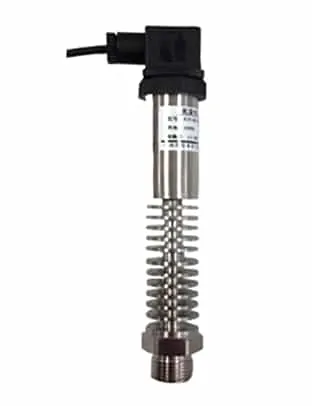Piezoresistive Differential Pressure Transmitter utilizes the piezoresistive effect of semiconductor silicon materials. Realize accurate measurement of differential pressure.
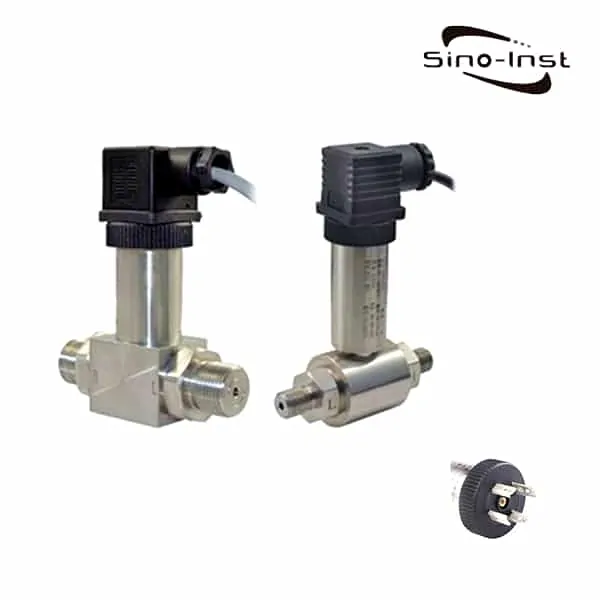
Piezoresistive Differential Pressure Transmitter uses integrated all-welded differential pressure measuring elements. Silicone oil is filled between the chip and the two corrugated diaphragms. This product utilizes the piezoresistive effect of semiconductor silicon materials. To achieve the conversion of differential pressure and electrical signals. The signal output from the Wheatstone bridge on the sensitive chip has a good linear relationship with the differential pressure. Therefore, accurate measurement of the measured differential pressure can be achieved. It is suitable for differential pressure measurement of various gases and liquids in petroleum, chemical.
Sino-Inst offers a variety of DP transmitters for industrial pressure measurement. If you have any questions, please contact our sales engineers.
Features of Piezoresistive Differential Pressure Transmitter
- All stainless steel structure design;
- Small size, light weight and easy installation;
- Welded structure, fully sealed;
- Enclosure protection grade IP65;
- The sensor is a diffused silicon piezoresistive differential pressure sensor, stainless steel 316L isolation diaphragm;
- After temperature compensation and aging screening, the performance is stable and reliable;
- Connector type products can adjust the zero point and fullness externally;
Specifications of Piezoresistive Differential Pressure Transmitter
| Range: | 0 ~ 10KPa ~ 35MPa |
| Withstand voltage: | three times the range value |
| Comprehensive accuracy: | 0.2% FS, 0.5% FS |
| Input and output signals: | 4-20mA (two-wire system), 0-5 / 1-5 / 0-10VDC (three-wire system) |
| Supply voltage: | 24VDC (10-30VDC) |
| Medium temperature: | -20 ~ 65 ℃ |
| Ambient temperature: | -20 ~ 65 ℃ |
| Load resistance: | Current output type: maximum 800Ω; voltage output type: greater than 50KΩ |
| Insulation resistance: | Greater than 2000MΩ (100VDC) |
| Sealing grade: | IP65 |
| Long-term stability: | 0.1% FS / year |
| Vibration effect: | Within the mechanical vibration frequency 20Hz ~ 1000Hz, the output change is less than 0.1% FS |
| Electrical interface: | Hessman connector ( Support customization) |
| Mechanical connection (thread interface): | M20 × 1.5, G1 / 2 |
Dimensions

Applications
- Flow measurement
- Wastewater treatment
- Wind Diff Pressure undermine
- Water Diff Pressure at hydropower station
- urban flood control and waterlogging prevention
- Underwater engineering
- Groundwater monitoring
- Central air-conditioning terminal control
- Watersaving Irrigation
Working Principle of Piezoresistive Differential Pressure Transmitter
The sensitive element of the piezoresistive differential pressure transmitter is a solid piezoresistive sensitive chip. Silicone oil is filled between the chip and the two corrugated diaphragms.
The measured differential pressure acts on the corrugated diaphragms at both ends. The differential pressure is transmitted to the sensitive chip through silicone oil. The sensitive chip is connected to the special amplifier circuit through the wire. It utilizes the piezoresistive effect of semiconductor silicon materials.
To achieve the conversion of differential pressure and electrical signals. The signal output from the Wheatstone bridge on the sensitive chip has a good linear relationship with the differential pressure.
Therefore, accurate measurement of the measured differential pressure can be achieved. It is used to measure the pressure difference of various gases and liquids. It is suitable for the measurement of differential pressure and water level difference of pipelines in petroleum and chemical industries.
Read more: Differential Pressure Transmitter Installation Guide
The Piezoresistive Effect
The so-called piezoresistive effect refers to the phenomenon that when the semiconductor is subjected to stress, the energy band changes due to the stress, the energy of the energy valley moves, and its resistivity changes.
It was discovered by C.S Smith in the 1954 test of the resistivity and stress change characteristics of silicon and germanium. Semiconductor piezoresistive sensors have been widely used in aviation, chemical, marine, power and medical sectors.
More about Piezoresistive effect From Wikipedia.
Strain pressure sensor VS piezoresistive pressure sensor
In principle, strain-type pressure sensors are caused by changes in the geometry (length or width) of the strained material caused by external pressure (or tension). This in turn causes the resistance of the material to change. The magnitude of the external force can be measured by detecting this resistance change.
Piezoresistive pressure sensors are usually semiconductor pressure sensitive materials. After the semiconductor piezoresistive sensor is subjected to external forces, its own geometry hardly changes. Instead, its lattice parameters change, affecting the width of the forbidden band. Even a very small change in the width of the forbidden band will cause a large change in carrier density. This eventually causes the resistivity of the material to change.
It can be seen that although both materials exhibit changes in resistance to changes in external force, the principles are different. In addition, the sensitivity of strain-type materials to external forces is much lower than that of semiconductor piezoresistive materials.
The sensitivity of the latter is about 100 times that of the former. The characteristics of strained materials are less affected by temperature. Semiconductor piezoresistive materials are sensitive to temperature.
Piezoresistive pressure sensor advantages and disadvantages
Advantages of piezoresistive pressure sensor:
- High frequency response, f0 can reach 1.5M;
- Small size and low power consumption;
- High sensitivity, good accuracy, can measure to 0.1% accuracy;
- No moving parts (the sensitive element is integrated with the conversion element).
Disadvantages of piezoresistive pressure sensor:
- Poor temperature characteristics;
- The process is complicated.
Techincal Support
Capacitive mems pressure sensor
A MEMS pressure sensor is a thin-film element. It deforms when subjected to pressure, and it can be measured using a strain gauge (piezoresistive sensing). It can also be measured by capacitively sensing the change in the distance between the two surfaces.
Capacitive pressure sensor is a pressure sensor that uses a capacitive sensing element to convert the measured pressure into an electrical output with a certain relationship. The characteristics are: low input energy, high dynamic response, small natural effect, good environmental adaptability.
Capacitive differential pressure sensor
Capacitive differential pressure sensor is filled with silicone oil in the left and right chambers of the measuring diaphragm. When the left and right isolation diaphragms are subjected to high pressure pH and low pressure pL respectively, the incompressibility and fluidity of the silicone oil can transmit the differential pressure Δp = pH-pL Measure the left and right sides of the diaphragm.
Because the measuring diaphragm is pre-tensioned before welding, it is very flat when the differential pressure Δp = 0. It makes the capacitances of the two capacitors on the left and right sides of the fixed plate are completely equal. That is, CH = CL. When there is a differential pressure effect, the measuring diaphragm deforms. That is, the moving electrode plate approaches the low voltage electrode plate. At the same time, it moves away from the high voltage measuring electrode plate. This makes the capacitance CH = CL.
More Featured Piezoresistive Pressure Sensor
What is a piezoresistive pressure sensor?
Piezoresistance pressure sensor (piezoresistance type transducer) is a kind of pressure sensor. Piezoresistive pressure sensors, also known as diffused silicon pressure sensors, refer to sensors made using the piezoresistive effect of single crystal silicon materials and integrated circuit technology. The single crystal silicon material is subjected to force. The resistivity changes. The electrical signal output proportional to the force change can be obtained through the measuring circuit. Piezoresistive sensors are used for the measurement and control of pressure, tension, pressure difference, and other physical quantities that can be transformed into changes in force. Such as liquid level, acceleration, weight, strain, flow rate, vacuum degree.
How does a piezoresistive pressure sensor work?
Working principle of piezoresistive pressure sensor:
It is the resistance change when the varistor is pressed. It is amplified by the amplifier and calibrated with standard pressure. The pressure can be detected. The performance of the piezoresistive pressure sensor mainly depends on the varistor (ie varistor), the amplifier circuit, and the calibration and aging process in production.
What do piezoresistive sensors measure?
Using the semiconductor piezoresistive effect, various types of piezoresistive sensors can be designed. The piezoresistive sensor has a small volume, a relatively simple structure, and high sensitivity. It can measure micro-pressures of more than ten micropascals, with good dynamic response. Good long-term stability, low hysteresis and creep. High frequency response, easy production, and low cost. Therefore, piezoresistive sensors have been widely used in measuring pressure, differential pressure, liquid level, acceleration and flow.
How do you test a pressure sensor?
There are 3 commonly used detection methods for pressure sensors. Hope it can help you.
1. Pressure test. The method of detection is to power the sensor. Use your mouth to blow the air hole of the pressure sensor. Use the voltage file of a multimeter to detect the voltage change at the output of the sensor. If the relative sensitivity of the pressure sensor is large, this amount of change will be significant. If there is no change at all, you need to use a pneumatic source to apply pressure.
Through the above method, you can basically detect the condition of a sensor. If accurate testing is required, a standard pressure source is required. Give pressure to the sensor, and calibrate the sensor according to the pressure and the change of the output signal. And when conditions permit, the temperature detection of relevant parameters.
2. Zero point detection. Use the voltage range of the multimeter to detect the zero output of the sensor under no pressure. This output is generally a voltage of mV level. If it exceeds the technical specifications of the sensor, it means that the zero deviation of the sensor is out of range.
3. Detection of bridges. It mainly detects whether the circuit of the sensor is correct. It is generally a Wheatstone full-bridge circuit. Use the ohm file of the multimeter. Measure the impedance between the input terminals and the impedance between the output terminals. These two impedances are the input and output impedances of the pressure sensor. If the impedance is infinite, the bridge is disconnected. It means there is a problem with the sensor or the definition of the pin is not correct.
Sino-Instrument offers over 10 Piezoresistive Differential Pressure Transmitters. A wide variety of Piezoresistive Differential Pressure Transmitter options are available to you. Such as free samples, paid samples. Sino-Instrument is a globally recognized manufacturer of Pressure sensors, located in China. Sino-Instrument sells through a mature distribution network that reaches all 30 countries worldwide. Piezoresistive Differential Pressure Transmitter products are most popular in Europe, Southeast Asia, and Mid East. You can ensure product safety by selecting from certified suppliers. With ISO9001, ISO14001 certification.
Request a Quote

Wu Peng, born in 1980, is a highly respected and accomplished male engineer with extensive experience in the field of automation. With over 20 years of industry experience, Wu has made significant contributions to both academia and engineering projects.
Throughout his career, Wu Peng has participated in numerous national and international engineering projects. Some of his most notable projects include the development of an intelligent control system for oil refineries, the design of a cutting-edge distributed control system for petrochemical plants, and the optimization of control algorithms for natural gas pipelines.



